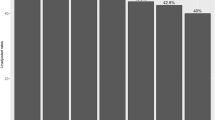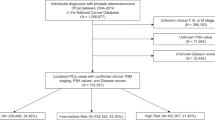Abstract
Background
Data regarding North-American incidental (cT1a/b) prostate cancer (PCa) patients is scarce. To address this, incidental PCa characteristics (age, PSA values at diagnosis, Gleason score [GS]), subsequent treatment and cancer-specific survival (CSS) rates were explored.
Methods
Incidental PCa patients were identified within the Surveillance, Epidemiology, and End Results (SEER) database (2004-2015). Descriptive statistics, annual percentage changes (EAPC), Kaplan-Meier estimates, as well as Cox regression models were used. Bootstrapping technique was used to generate 95% confidence intervals for CSS at 6 years.
Results
Of all 344,031 newly diagnosed non metastatic PCa patients, 5155 harbored incidental PCa. Annual rates of incidental PCa increased from 1.9% (2004) to 2.5 % (2015; p = 0.02). PSA values at diagnosis were 0–4 ng/ml in 48% vs. 4–10 ng/ml in 31% vs. > 10 ng/ml in 21%. Of all incidental PCa patients, 64% harbored GS 6 vs. 25% GS 7 vs. 11% GS ≥ 8. Of all incidental PCa patients, 47% were aged < 70, 35% were between 70 and 79 and 18% were ≥ 80 years. Subsequently, 71% underwent no local treatment (NLT) vs. 16% radical prostatectomy (RP) vs. 14% radiotherapy (RT). Proportions of patients with NLT increased from 65 to 81% (p = 0.0001) over the study period (2004–2015). CSS at six years ranged from 58% in GS ≥ 8 patients with NLT to 100% in patients who harbored GS 6 and underwent either RP or RT.
Conclusion
Incidental PCa in the United States is rare. Most incidental PCa patients are diagnosed in men aged less than 80 years of age. The majority of incidental PCa patients undergo NLT and enjoy excellent CSS.
This is a preview of subscription content, access via your institution
Access options
Subscribe to this journal
Receive 4 print issues and online access
$259.00 per year
only $64.75 per issue
Buy this article
- Purchase on Springer Link
- Instant access to full article PDF
Prices may be subject to local taxes which are calculated during checkout


Similar content being viewed by others
Data availability
All data generated for this analysis were from the Surveillance, Epidemiology, and End Results Research Plus (SEER) database. The code for the analyses will be made available upon request.
References
Sato S, Kimura T, Onuma H, Egawa S, Takahashi H. Transition zone prostate cancer is associated with better clinical outcomes than peripheral zone cancer. BJUI Compass. 2021;2:169.
Andersson TML, Myklebust TÅ, Rutherford MJ, Møller B, Soerjomataram I, Arnold M, et al. The impact of excluding or including Death Certificate Initiated (DCI) cases on estimated cancer survival: A simulation study. Cancer Epidemiol. 2021;71:101881.
Cause of Death Recode - SEER Recodes. https://seer.cancer.gov/codrecode/ (accessed 12 Jun 2023).
Fay MP, Tiwari RC, Feuer EJ, Zou Z. Estimating average annual percent change for disease rates without assuming constant change. Biometrics. 2006;62:847–54.
R: The R Project for Statistical Computing. https://www.r-project.org/ (accessed 4 Jun 2023).
Hagmann S, Ramakrishnan V, Tamalunas A, Hofmann M, Vandenhirtz M, Vollmer S, et al. Two decades of active surveillance for prostate cancer in a single-center cohort: favorable outcomes after transurethral resection of the prostate. Cancers. 2022;14:368.
Capogrosso P, Capitanio U, Vertosick EA, Ventimiglia E, Chierigo F, Oreggia D, et al. Temporal trend in incidental prostate cancer detection at surgery for Benign prostatic hyperplasia. Urology. 2018;122:152–7.
Hutchison D, Peabody H, Kuperus JM, Humphrey JE, Ryan M, Moriarity A, et al. Management of prostate cancer after holmium laser enucleation of the prostate. Urologic Oncol: Seminars Original Investig. 2021;39:297.e1–297.e8.
Tsaur I, van den Bergh RCN, Soeterik T, Thomas A, Brandt MP, Zattoni F, et al. Predictors of Unfavorable Pathology in Patients with Incidental (pT1a–T1b) Prostate Cancer. Eur Urol Focus. 2022;8:1599–606.
Cheng BKC, Castellani D, Chan ISH, Baker A, Gauhar V, Wroclawski ML, et al. Incidence, predictive factors and oncological outcomes of incidental prostate cancer after endoscopic enucleation of the prostate: a systematic review and meta-analysis. World J Urol. 2022;40:87–101.
Hilscher M, Røder A, Helgstrand JT, Klemann N, Brasso K, Vickers AJ, et al. Risk of prostate cancer and death after benign transurethral resection of the prostate—A 20-year population-based analysis. Cancer. 2022;128:3674–80.
Lin J, Yu X, Yang X, Jin J, Zhou L, Liu L, et al. High incidence of incidental prostate cancer in transurethral resection of prostate specimens in China. The value of pathologic review. Anal Quant Cytopathol Histpathol. 2016;38:31–7.
Mottet N, van den Bergh RCN, Briers E, Van den Broeck T, Cumberbatch MG, De Santis M, et al. EAU-EANM-ESTRO-ESUR-SIOG Guidelines on Prostate Cancer-2020 Update. Part 1: Screening, Diagnosis, and Local Treatment with Curative Intent. Eur Urol. 2021;79:243–62.
Author information
Authors and Affiliations
Contributions
Concept and design: LS, FB, PIK. Data management and analysis: R-BI, SM, AB, AA, LMIJ, CS, MdA, ZT. Manuscript writing: LS, PIK, SA. Interpretation and supervision: FS, SFS, AB, FKHC, DT, NL, LC, ODC. Final approval of manuscript: all authors.
Corresponding author
Ethics declarations
Competing interests
The authors declare no competing interests.
Ethics approval
All analyses and their reporting followed the SEER reporting guidelines. Due to the anonymously coded design of the SEER database, study-specific Institutional Review Board ethics approval was not required.
Additional information
Publisher’s note Springer Nature remains neutral with regard to jurisdictional claims in published maps and institutional affiliations.
Supplementary information
Rights and permissions
Springer Nature or its licensor (e.g. a society or other partner) holds exclusive rights to this article under a publishing agreement with the author(s) or other rightsholder(s); author self-archiving of the accepted manuscript version of this article is solely governed by the terms of such publishing agreement and applicable law.
About this article
Cite this article
Scheipner, L., Incesu, RB., Morra, S. et al. Characteristics of incidental prostate cancer in the United States. Prostate Cancer Prostatic Dis (2023). https://doi.org/10.1038/s41391-023-00742-7
Received:
Revised:
Accepted:
Published:
DOI: https://doi.org/10.1038/s41391-023-00742-7



